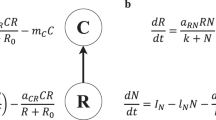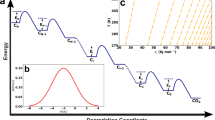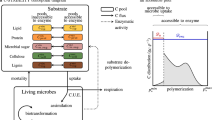Abstract
ALTHOUGH ecosystem behaviour is ultimately determined by the combination of energy flow through the system and material cycling within it, remarkably little effort has been directed towards elucidating the effects of material cycling on ecosystem stability, noteworthy exceptions being the works of Ulanowicz1, May2, and Dudzik et al.3. Ulanowicz1 and May2 studied a model of a linear trophic chain in which both the biomass and energy fluxes between any two levels involved bilinear sums of the biomasses of all the species present and concluded that the system was stable only if the specific energy (that is, energy content per unit biomass) increased on ascending the trophic chain. Although producers are normally found to have a lower specific energy than consumers, there seems to be little or no significant difference between the specific energy of different consumer levels (see, for example, refs 4 and 5). The implication of the Ulanowicz–May model is thus that the stability of a trophic chain is a fragile property dependent on small differences in specific energy between levels. We believe that this result is due to a neglect of the distinctive nature of the dynamics of the decomposition of biological material to inorganic material, a viewpoint consistent with the results of Dudzik et al.3 who analysed a number of detailed models of nutrient cycles in both open and closed ecosystems. Here we propose an alternative model of a trophic chain, which suggests that the effect of material cycling is to stabilise the system.
This is a preview of subscription content, access via your institution
Access options
Subscribe to this journal
Receive 51 print issues and online access
$199.00 per year
only $3.90 per issue
Buy this article
- Purchase on Springer Link
- Instant access to full article PDF
Prices may be subject to local taxes which are calculated during checkout
Similar content being viewed by others
References
Ulanowicz, R. E., J. theor. Biol., 34, 239 (1972).
May, R. M., J. theor. Biol., 39, 155 (1973).
Dudzik, M., Harte, J., Levy, D., and Sandusky, J., Lawrence Berkeley Rep. LBL-3264 (1975).
Morowitz, H. T., Energy Flow in Biology (Academic, New York and London, 1968).
Odum, E. P., Fundamentals of Ecology (Saunders, Philadelphia, 1971).
Whittaker, R. H., Communities and Ecosystems, 112 (Macmillan, London, 1970).
May, R. M., Stability and Complexity in Model Ecosystems (Princeton University, Princeton, 1973).
Author information
Authors and Affiliations
Rights and permissions
About this article
Cite this article
NISBET, R., GURNEY, W. Model of material cycling in a closed ecosystem. Nature 264, 633–634 (1976). https://doi.org/10.1038/264633a0
Received:
Accepted:
Issue Date:
DOI: https://doi.org/10.1038/264633a0
This article is cited by
-
Material recycling in a closed aquatic ecosystem. II. Bifurcation analysis of a simple food-chain model
Bulletin of Mathematical Biology (1996)
-
Oscillations in a system with material cycling
Journal of Mathematical Biology (1988)
-
Global stability of partially closed food-chains with resources
Bulletin of Mathematical Biology (1986)
Comments
By submitting a comment you agree to abide by our Terms and Community Guidelines. If you find something abusive or that does not comply with our terms or guidelines please flag it as inappropriate.



